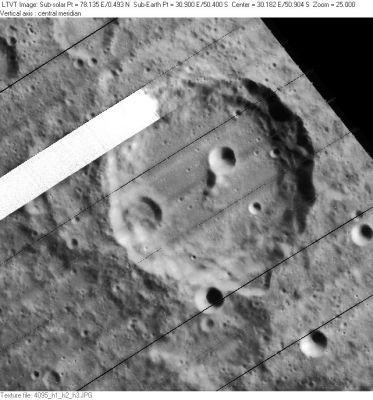Pitiscus
Contents
Pitiscus
|
Lat: 50.4°S, Long: 30.9°E, Diam: 82 km, Depth: 4.63 km, Rükl 75, Nectarian |
Table of Contents

LO-IV-095H The sharp 10-km crater on the floor of Pitiscus (touching the central peak) is Pitiscus A. To its southwest (on the inner wall) is 13-km Pitiscus E. Still farther to the east, under the white blemish, is 24-km Pitiscus W. The 9-km bright-ray crater Pitiscus L is partially covered by the right margin. Due south of Pitiscus, the faint 43-km depression is Hommel H with 8-km Hommel HA at the position where its rim merges with Pitiscus. To the right of Hommel H is 11-km Hommel R. The only other IAU-named feature in this field is 25-km Pitiscus R, partially visible (to the left) along the top margin.
Images
LPOD Photo Gallery Lunar Orbiter Images Apollo Images
Maps
(LAC zone 127B1) LAC map Geologic map
Description
Description: Elger
(IAU Directions) PITISCUS.--The most regular of the Vlacq group. It is situated on the N.W. of Hommel (a curious oblong-shaped enclosure, Hommel h, with a very attenuated W. wall, and a large crater on a floor, standing at a higher level than that of Pitiscus, intervening). It is 52 miles in diameter, and is surrounded by an apparently continuous rampart, except on the W., where there is a crater, and on the S.E., where it abuts on Hommel h. Here there is a wide gap crossed by what has every appearance of being a "fault," resembling that in Phocylides on a smaller scale. There is a fine crater on the N. side of the interior connected with the S. wall by a bright ridge. Just beyond the W. border there is a shallow ring-plain of a very extraordinary shape.
Description: Wikipedia
Additional Information
- Depth data from Kurt Fisher database
- Westfall, 2000: 4.63 km
- Viscardy, 1985: 3 km
- Cherrington, 1969: 3.1 km
- Central peak composition: A, GNTA1 & GNTA2 (Tompkins & Pieters, 1999)
- Pitiscus and its satellite Pitiscus A and Pitiscus L are on the ALPO list of bright ray craters.
Nomenclature
Bartholemaeus; German mathematician (1561-1613).
- According to Whitaker (pp. 213-214), this name was introduced by Riccioli, however the feature labeled with this name on Riccioli's map is what we now call Vlacq, and the feature we now call Pitiscus (the present feature) was called Homelius (Riccioli's spelling of Hommel). When, and by whom, the names were later rearranged is not entirely clear (from Whitaker's book). - JimMosher JimMosher
LPOD Articles
Bibliography
This page has been edited 1 times. The last modification was made by - tychocrater tychocrater on Jun 13, 2009 3:24 pm - afx3u2